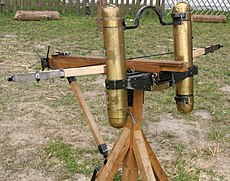Scorpio (weapon)

 |
| Part of a series on the |
| Military of ancient Rome |
|---|
|
|
Scorpio (Dart-thrower) (Polybolos) was a Roman artillery piece invented in 50 BC.[citation needed] Also known by the name of the triggerfish, it was described in detail by Vitruvius, with the next major improvement being the Cheiroballista.[1] This weapon of remarkable precision and power was particularly dreaded by the enemies of the Roman Empire.
The Scorpio was a smaller weapon, more of a sniper weapon than a siege engine, being operated by only one person. The scorpio was basically a primitive giant crossbow, a 'catapult with bolts', probably first invented by the Greeks, then later adopted and used on a larger scale by the Roman legions. This catapult used a system of springs with torsion, making it possible to obtain very great power and thus a high speed of ejection for the bolts.
During the Roman Republic and early empire eras, 60 scorpio per legion was the standard, or one for every centuria. The scorpio had mainly two functions in a legion: in tended shooting, it was a weapon of marksmanship capable of cutting down any foe within a distance of 100 meters. During the siege of Avaricum in the war against the Gauls, Julius Caesar describes the terrifying precision of the scorpio. In parabolic shooting, the range is greater, with distances up to 400 meters, the firing rate is higher (3 to 4 shots per minute) but the precision is significantly less.
Scorpio were typically used in a “battery” at the top of a hill or other high ground, the side of which was protected by the main body of the legion. In this case, there are 60 scorpions present which can fire up to 250 bolts per minute at the enemy army. The weight and speed of a bolt was sufficient to transpierce enemy shields, and usually also sufficient to wound (or outright kill) the warriors who opposed them.
The complexity of construction, adjustment and the great sensitivity to any variation in temperature or moisture limited their use, due to the spring of torsion which the Romans referred to as “tormenta”. Moreover, this type of technology, which disappeared as of the High Middle Ages (with the exception of the Byzantine Empire), reappeared during the First Crusade with a new type of catapult based on a system of slings and counterweights which gave rise to the precision balances for the projection of stone balls or giant crossbows (thanks to the progress made in the field of metallurgy).
Gallery
-
Modern reconstruction
-
Scorpio in fortified position
-
Scorpio mounted on walls
-
Dacian scorpio
References
- ^ Warry, J.(1995). Warfare in the Classical World. Pg.178 Salamander Books Ltd., London: United Kingdom. ISBN 0-8061-2794-5




